Navigation
Researchers Discover Source of Essential Nutrients for Mid-Ocean Algae
For almost three decades, oceanographers have been puzzled by the ability of microscopic algae ("microalgae") to grow in open-ocean areas where there is very little nitrate, an essential nutrient for the algae.
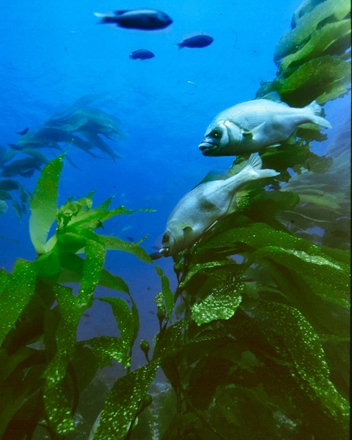 |
| Monterey Bay's kelp forests and many other ocean ecosystems are sustained by microalgae. Photograph credit: NOAA |
For almost three decades, oceanographers have been puzzled by the ability of microscopic algae ("microalgae") to grow in open-ocean areas where there is very little nitrate, an essential nutrient for the algae.
In this week's issue of the journal Nature, Monterey Bay Aquarium Research Institute (MBARI) chemical oceanographer Ken Johnson, along with co-authors Stephen Riser at the University of Washington and David Karl at the University of Hawaii, show that open-ocean microalgae obtain nitrate from deep waters as much as 250 meters below the surface.
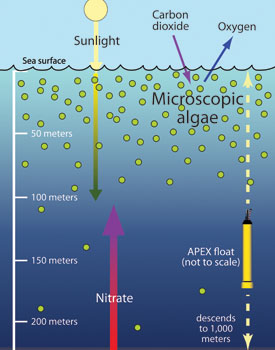 |
| This illustration shows how microscopic algae live mostly in the sunlit waters close to the sea surface, while their essential nutrient, nitrate, is only available in deeper waters. Johnson and his coauthors showed that, each year, as the algae grow over the course of a year, concentrations of oxygen increase in surface waters while concentrations of nitrate decrease in deeper water. As yet unclear is how algae near the surface obtain nitrate from the depths. Image credit: Kim Fulton-Bennett © 2010 MBARI |
The finding will help scientists predict how open-ocean ecosystems could respond to global warming.
The sea around Hawaii may be clear and blue, but beneath the surface has been an enduring oceanographic mystery. Surface waters in this and other open-ocean areas contain almost no nitrate or other plant nutrients. Yet each year, microscopic algae flourish in these vast regions. In the process the algae consume about one-fifth of all the carbon dioxide taken up by plants worldwide.
To solve the mystery, Johnson and colleagues used a robotic drifter called an Apex float, which automatically moves from the sea's surface down to 1,000 meters and back again, profiling the water column as it goes.
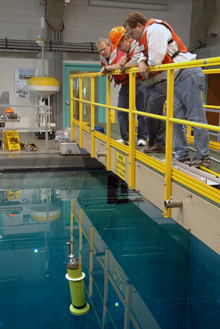 |
| Researchers observe the Apex float equipped with an ISUS in the MBARI test tank. Image credit: Todd Walsh © 2007 MBARI |
Researchers at the University of Washington outfitted the drifter with an oxygen sensor and a custom version of Johnson's In-situ Ultraviolet Spectrometer (ISUS), which measures nitrate concentrations in seawater.
The design and deployment of this custom drifter was funded by the National Science Foundation (NSF).
"This elegant study very nicely answers a long-standing question," says Don Rice, director of NSF's chemical oceanography program, "not just for the Pacific Ocean, but for much of the rest of the world oceans as well: how does deep-water feed life at the surface? We now have some answers."
In December 2007, researchers from the University of Hawaii placed the drifter in the ocean northeast of Oahu, where it collected ocean profiles once every five days for almost two years.
From January through October of each year, the instruments on the drifter showed a gradual increase in oxygen concentrations in the upper 100 meters of the ocean.
At the same time, the float detected a gradual decrease in concentrations of nitrate in deeper waters 100 to 250 meters below the surface.
Johnson and co-authors found that the amount of oxygen produced near the surface through photosynthesis was directly proportional to the amount of nitrate consumed in deeper water.
Based on the decline in nitrate concentrations at depth, the researchers estimated how much algal growth could have taken place during the year. Their estimates of algal growth were very similar to algal growth rates measured during the University of Hawaii's oceanographic cruises in that part of the Pacific Ocean.
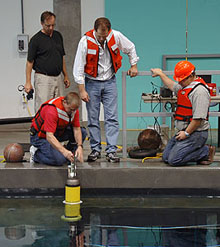 |
| Ken Johnson and his fellow researchers work on the Apex float equipped with an ISUS in the MBARI test tank. From left to right, the researchers are: Ken Johnson (MBARI), Stephen Riser (University of Washington), Luke Coletti (MBARI), and Hans Jannasch (MBARI). Image credit: Todd Walsh © 2007 MBARI |
Because there is not enough sunlight for algae to grow below 100 meters, the researchers conclude that algae growing near the surface somehow obtain nitrate from deeper waters, and use this nitrate to grow and reproduce. Exactly how the algae obtain these deep nutrients is still unclear. One possible mechanism is ocean eddies.
Satellite and drifter data suggest that slow, swirling eddies occasionally form hundreds of meters below the surface of the Pacific. ISUS data demonstrate that some of these eddies can carry nitrate upward to about 70 meters below the ocean surface.
Yet these pulses of nitrate do not appear to reach the upper 50 meters of the water column, where most of the algae grow. The scientists speculate that dormant microalgae may inhabit the waters below 100 meters.
Open-ocean eddies may occasionally carry these algae upward, to depths of perhaps 70 meters. At this point, the algae may consume any available nitrate and then migrate farther up into surface waters.
Johnson suggests that testing this hypothesis will provide an interesting challenge for marine biologists.
Scientists already know that some algae can swim, using tiny, whip-like flagellae. Other algae can actively change their bouyancy, just like the Apex float, and either sink down or float upward.
Over the next year or two, the oceanographers will outfit several groups of drifters with nitrate and oxygen sensors.
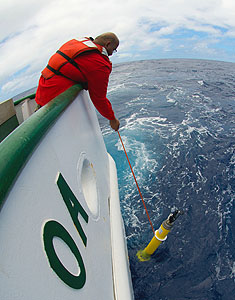 |
| A researcher from the University of Hawaii prepares to release the Apex float with its integrated ISUS nitrate sensor into the clear, mid-ocean waters northeast of Oahu. Image credit: © 2007 Paul Lethaby/SOEST |
Some of these drifters will be deployed near Hawaii. Others will be deployed near Bermuda in the mid-Atlantic. Still other drifters will be placed in the far North Pacific and in the Southern Ocean, where nitrate supplies and algal growth are typically high.
Such studies in the open ocean may seem remote from human activities on land. Yet the oxygen produced by open-ocean algae is essential for the survival of life on Earth.
When these algae die and sink to the seafloor, they remove huge amounts of carbon dioxide from Earth's atmosphere.
By moving massive amounts of carbon from the atmosphere into the ocean, the algae help control Earth's climate.
"The life you can't see without a microscope," says Johnson, "is doing all the work."
The research was also funded by the Office of Naval Research, the National Oceanic and Atmospheric Administration, the Gordon and Betty Moore Foundation, and the David and Lucile Packard Foundation.
The content of this article was provided by the National Science Foundation www.nsf.gov, June 23,2010.
Search
Latest articles
Agriculture
- World Water Week: Healthy ecosystems essential to human health: from coronavirus to malnutrition Online session Wednesday 24 August 17:00-18:20
- World Water Week: Healthy ecosystems essential to human health: from coronavirus to malnutrition Online session Wednesday 24 August 17:00-18:20
Air Pollution
- "Water and Sanitation-Related Diseases and the Changing Environment: Challenges, Interventions, and Preventive Measures" Volume 2 Is Now Available
- Global Innovation Exchange Co-Created by Horizon International, USAID, Bill and Melinda Gates Foundation and Others
Biodiversity
- It is time for international mobilization against climate change
- World Water Week: Healthy ecosystems essential to human health: from coronavirus to malnutrition Online session Wednesday 24 August 17:00-18:20
Desertification
- World Water Week: Healthy ecosystems essential to human health: from coronavirus to malnutrition Online session Wednesday 24 August 17:00-18:20
- UN Food Systems Summit Receives Over 1,200 Ideas to Help Meet Sustainable Development Goals
Endangered Species
- Mangrove Action Project Collaborates to Restore and Preserve Mangrove Ecosystems
- Coral Research in Palau offers a “Glimmer of Hope”
Energy
- Global Innovation Exchange Co-Created by Horizon International, USAID, Bill and Melinda Gates Foundation and Others
- Wildlife Preservation in Southeast Nova Scotia
Exhibits
- Global Innovation Exchange Co-Created by Horizon International, USAID, Bill and Melinda Gates Foundation and Others
- Coral Reefs
Forests
- NASA Satellites Reveal Major Shifts in Global Freshwater Updated June 2020
- Global Innovation Exchange Co-Created by Horizon International, USAID, Bill and Melinda Gates Foundation and Others
Global Climate Change
- It is time for international mobilization against climate change
- It is time for international mobilization against climate change
Global Health
- World Water Week: Healthy ecosystems essential to human health: from coronavirus to malnutrition Online session Wednesday 24 August 17:00-18:20
- More than 400 schoolgirls, family and teachers rescued from Afghanistan by small coalition
Industry
- "Water and Sanitation-Related Diseases and the Changing Environment: Challenges, Interventions, and Preventive Measures" Volume 2 Is Now Available
- Global Innovation Exchange Co-Created by Horizon International, USAID, Bill and Melinda Gates Foundation and Others
Natural Disaster Relief
- STOP ATTACKS ON HEALTH CARE IN UKRAINE
- Global Innovation Exchange Co-Created by Horizon International, USAID, Bill and Melinda Gates Foundation and Others
News and Special Reports
- World Water Week: Healthy ecosystems essential to human health: from coronavirus to malnutrition Online session Wednesday 24 August 17:00-18:20
- STOP ATTACKS ON HEALTH CARE IN UKRAINE
Oceans, Coral Reefs
- World Water Week: Healthy ecosystems essential to human health: from coronavirus to malnutrition Online session Wednesday 24 August 17:00-18:20
- Mangrove Action Project Collaborates to Restore and Preserve Mangrove Ecosystems
Pollution
- Zakaria Ouedraogo of Burkina Faso Produces Film “Nzoue Fiyen: Water Not Drinkable”
- "Water and Sanitation-Related Diseases and the Changing Environment: Challenges, Interventions, and Preventive Measures" Volume 2 Is Now Available
Population
- "Water and Sanitation-Related Diseases and the Changing Environment: Challenges, Interventions, and Preventive Measures" Volume 2 Is Now Available
- "Water and Sanitation-Related Diseases and the Changing Environment: Challenges, Interventions, and Preventive Measures" Volume 2 Is Now Available
Public Health
- Honouring the visionary behind India’s sanitation revolution
- Honouring the visionary behind India’s sanitation revolution
Rivers
- World Water Week: Healthy ecosystems essential to human health: from coronavirus to malnutrition Online session Wednesday 24 August 17:00-18:20
- Mangrove Action Project Collaborates to Restore and Preserve Mangrove Ecosystems
Sanitation
- Honouring the visionary behind India’s sanitation revolution
- Honouring the visionary behind India’s sanitation revolution
Toxic Chemicals
- "Water and Sanitation-Related Diseases and the Changing Environment: Challenges, Interventions, and Preventive Measures" Volume 2 Is Now Available
- Actions to Prevent Polluted Drinking Water in the United States
Transportation
- "Water and Sanitation-Related Diseases and the Changing Environment: Challenges, Interventions, and Preventive Measures" Volume 2 Is Now Available
- Urbanization Provides Opportunities for Transition to a Green Economy, Says New Report
Waste Management
- Honouring the visionary behind India’s sanitation revolution
- Honouring the visionary behind India’s sanitation revolution
Water
- Honouring the visionary behind India’s sanitation revolution
- Honouring the visionary behind India’s sanitation revolution
Water and Sanitation
- Honouring the visionary behind India’s sanitation revolution
- Honouring the visionary behind India’s sanitation revolution

